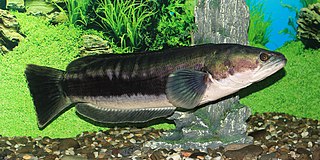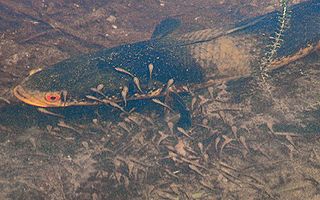
The northern snakehead is a species of snakehead fish native to China, Russia, North Korea, and South Korea, ranging from the Amur River to Hainan. It has been introduced to other regions, where it is considered invasive. In Europe, the first report of the species was from Czechoslovakia in 1956. In the United States, the fish is considered to be a highly invasive species.

Channa is a genus of predatory fish in the family Channidae, commonly known as snakeheads, native to freshwater habitats in Asia. This genus contains about 50 scientifically described species. The genus has a wide natural distribution extending from Iraq in the west, to Indonesia and China in the east, and parts of Siberia in the Far East. A particularly high richness of species exists in Myanmar (Burma) and northeastern India, and many Channa species live nowhere else. In contrast, a few widespread species have been introduced to several regions outside their natural range, where they often become invasive. The large and medium-sized Channa species are among the most common staple food fish in several Asian countries, and they are extensively cultured. Apart from their importance as a food fish, snakeheads are consumed in some regions as a traditional medicine for wound healing and reducing postoperative pain and discomfort, and collected for the international aquarium pet trade.

The Thamirabarani or Tamraparni or Porunai is a perennial river that originates from the Agastyarkoodam peak of Pothigai hills of the Western Ghats, above Papanasam in the Ambasamudram taluk. It flows through Tirunelveli and Thoothukudi districts of the Tamil Nadu state of southern India into the Gulf of Mannar. It was called the Tamraparni River in the pre-classical period, a name it lent to the island of Sri Lanka. The old Tamil name of the river is Porunai. From the source to sea, the river is about 128 kilometres (80 mi) long and is the only perennial river in Tamil Nadu. This river flows towards north direction initially. However, it changes to east direction later. On the banks of this river existed the Porunai Civilization.

The snakeheads are members of the freshwater perciform fish family Channidae, native to parts of Africa and Asia. These elongated, predatory fish are distinguished by their long dorsal fins, large mouths, and shiny teeth. They breathe air with gills, which allows them to migrate short distances over land. They have suprabranchial organs, which are primitive forms of labyrinth organs, that develop when they grow older. The two extant genera are Channa in Asia and Parachanna in Africa, consisting of more than 50 species.

The Barca snakehead is a rare species of snakehead. It is endemic to the upper Brahmaputra river basin in northeastern India and Bangladesh. Records from Nepal are of doubtful validity. Overall it has been assessed as data deficient by the IUCN, and in 2014 it was assessed as critically endangered in Bangladesh by the IUCN. In Assam, it is locally known as cheng garaka or garaka cheng.

Channa bleheri is a species of dwarf snakehead that is endemic to the Brahmaputra River basin in the Indian states of Assam and Arunachal Pradesh. It is among the most colorful species of snakehead.

Dwarf snakehead is a term coined by aquarists to describe a group of Channa snakehead fishes growing to about 25 cm (10 in) maximum. They are found in freshwater habitats in South and Southeast Asia, and southern China.

The forest snakehead is a species of snakehead, a fish of the family Channidae. Its range includes most of Southeast Asia and parts of southern China. It lives in forest streams and can reach 40 cm (16 in) in length. The forest snakehead is known in Thai language as pla krasong. Khmer language called it កញ្ជនជៃ, Indonesians named it kehung, while in Malaysia, they called it ikan bujuk in Malay Language

Channa gachua, the dwarf snakehead, is a species of fish in the family Channidae. The name "dwarf snakehead" is also used for several other species of small snakeheads. C. gachua is native to freshwater habitats in southern Asia, where it has a wide distribution from Iran to Indonesia. This fish is considered to be a species complex, a group of several closely related taxa with one name. It is likely at least three to four different species, and further research may differentiate them. A few species such as Channa harcourtbutleri have been separated from the complex in recent decades. The easternmost population of C. gachua is often recognized as a separate species C. limbata, while the isolated Sri Lankan population often is recognized as C. kelaartii.

Channa striata, the striped snakehead, is a species of snakehead fish. It is also known as the common snakehead, chevron snakehead, or snakehead murrel and generally referred simply as mudfish. It is native to South and Southeast Asia, and has been introduced to some Pacific Islands. Reports from Madagascar and Hawaii are misidentifications of C. maculata.

Amphibious fish are fish that are able to leave water for extended periods of time. About 11 distantly related genera of fish are considered amphibious. This suggests that many fish genera independently evolved amphibious traits, a process known as convergent evolution. These fish use a range of terrestrial locomotory modes, such as lateral undulation, tripod-like walking, and jumping. Many of these locomotory modes incorporate multiple combinations of pectoral-, pelvic-, and tail-fin movement.

The orange-spotted snakehead is a species of snakehead fish. Its body is of brownish colour intermixed with vertical orange stripes. Males have taller dorsal fins with more intense coloration, and narrower heads. It is endemic to Brahmaputra River basin. Its type locality is Dibrugarh, the most northeastern area of Assam, India. Dibrughar is the same type locality as that of Channa bleheri.

Channa micropeltes, giant snakehead, giant mudfish or Indonesian snakehead, is among the largest species in the family Channidae, capable of growing to 1.5 m (4.9 ft) in length and a weight of 20 kg (44 lb). It is native to the fresh waters of Southeast Asia, but has also been introduced elsewhere, where considered invasive. Other names include xal mas in Assamese, red snakehead, redline snakehead, and ikan toman.

The South Branch Wildlife Management Area is 1,092 acres (4.42 km2) of mixed oak-hickory woodlands and pastures in Hampshire and Hardy Counties, West Virginia, USA. The South Branch WMA consists of four separate tracts along the South Branch Potomac River around and south of the river gorge known as The Trough. It is known throughout the region for its dove, squirrel, deer, and wild turkey hunting. The WMA is owned by the West Virginia Division of Natural Resources.

The Allegheny Wildlife Management Area is located on 6,202 acres (25.1 km2) on two separate tracts of mixed oak-hickory woodlands in western Mineral County along the Allegheny Front. The large land tract of 5,034 acres (2,037.2 ha) is accessible via Pinnacle Road and Pine Swamp Road four miles (6 km) southwest of Keyser. The smaller tract of 1,168 acres (4.7 km2) is accessed by West Virginia Route 46 and Barnum Road about 6 miles (10 km) north from Elk Garden. The Barnum Road tract consists of old farm fields along the river and the ridgetop, connected by steep slopes.

The Ceylon snakehead is a species of snakehead found in freshwater habitats, typically shaded streams, in southwestern Sri Lanka.

Channa marulius is a large species of snakehead native to South Asia. Populations in Southeast Asia are now regarded as separate species.
The black snakehead is a species of snakehead native to Thailand, Indonesia, Malaysia, Philippines, and Singapore. This commercially important species reaches a length of 30 cm (12 in). The Black Snakehead inhabits large to medium rivers that consists of acidic water and submerged roots. The Black Snakehead feeds on small animals and harmless to humans beings. Snakehead fish have long, slender bodies with long dorsal and butt-centric balances. They have an extensive mouth and distending jaw with canine-like teeth. ]
The blotched snakehead is a species of snakehead. It is one of four species of the genus Channa native to China. It is also to native northern Vietnam and Taiwan, but has been widely introduced to other countries, where it is an invasive species. This predatory species typically grows to a length of 20–30 cm (7.9–11.8 in), but it has been confirmed at 33 cm (13 in) and some suggest it may reach a far larger size.
















